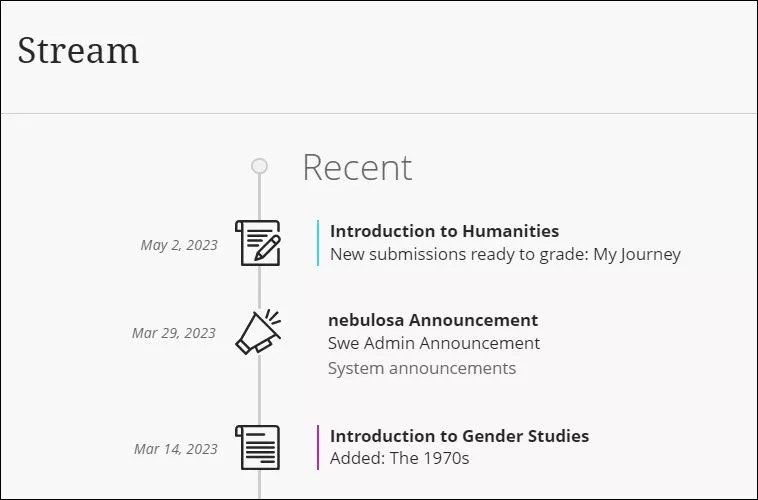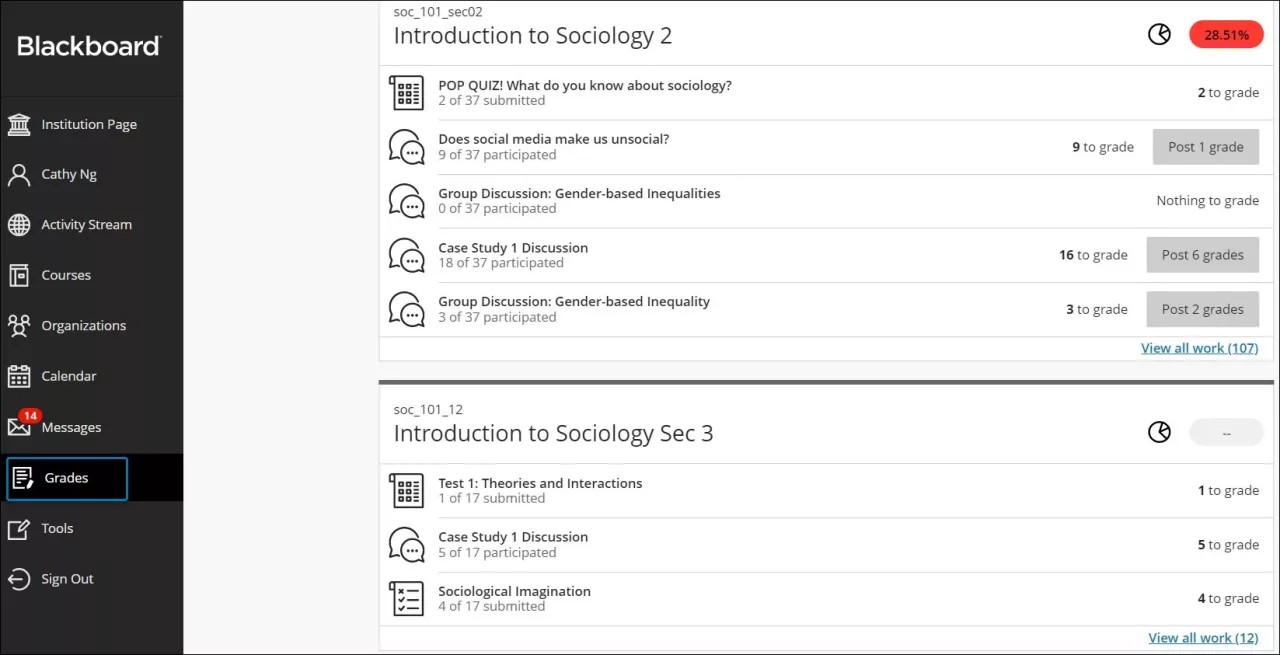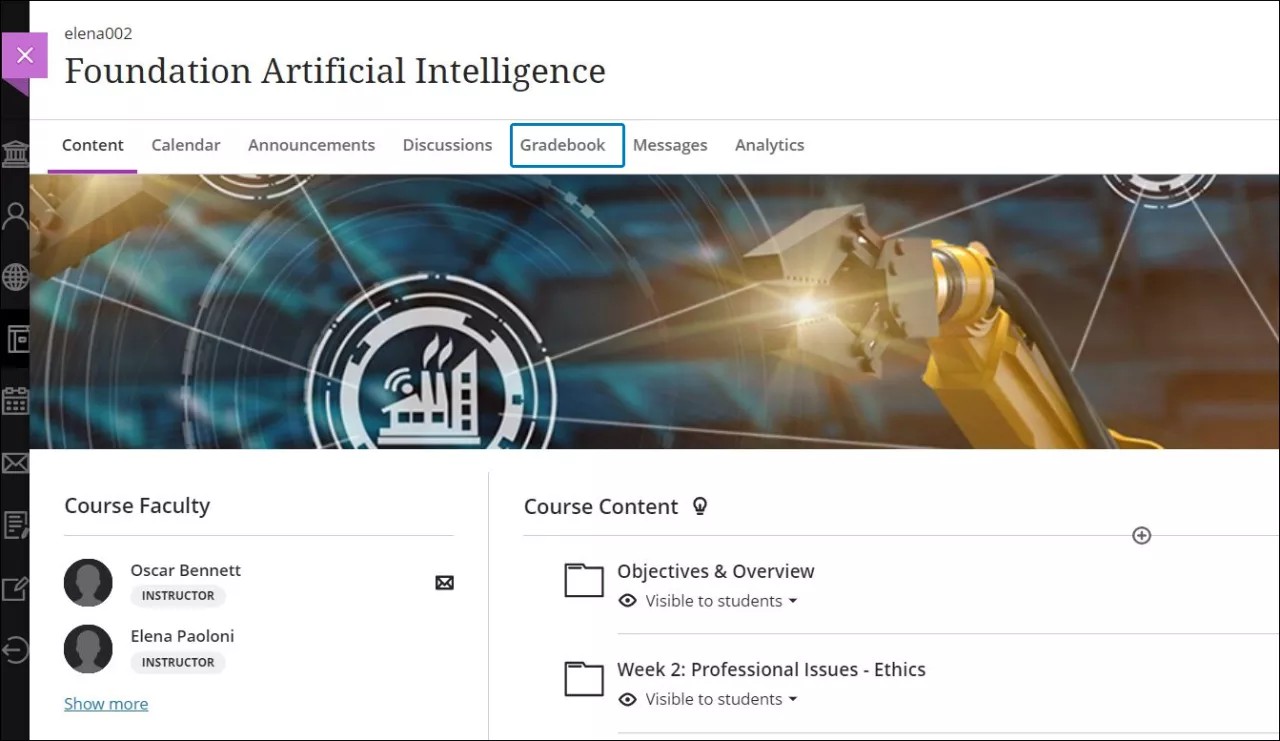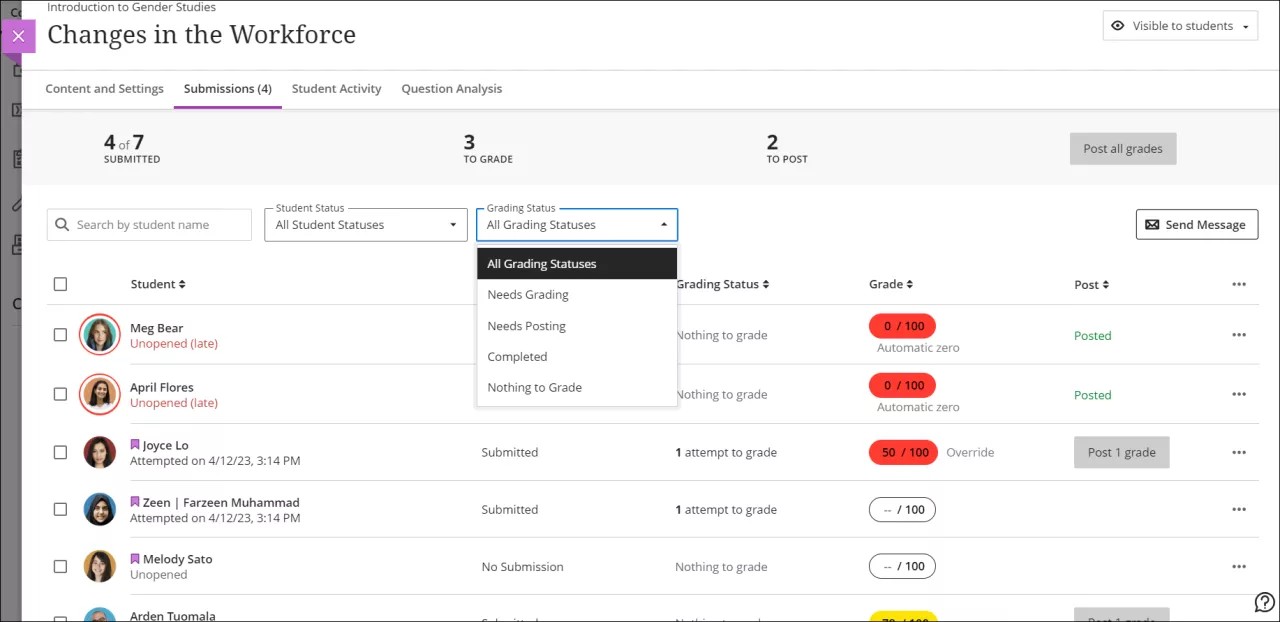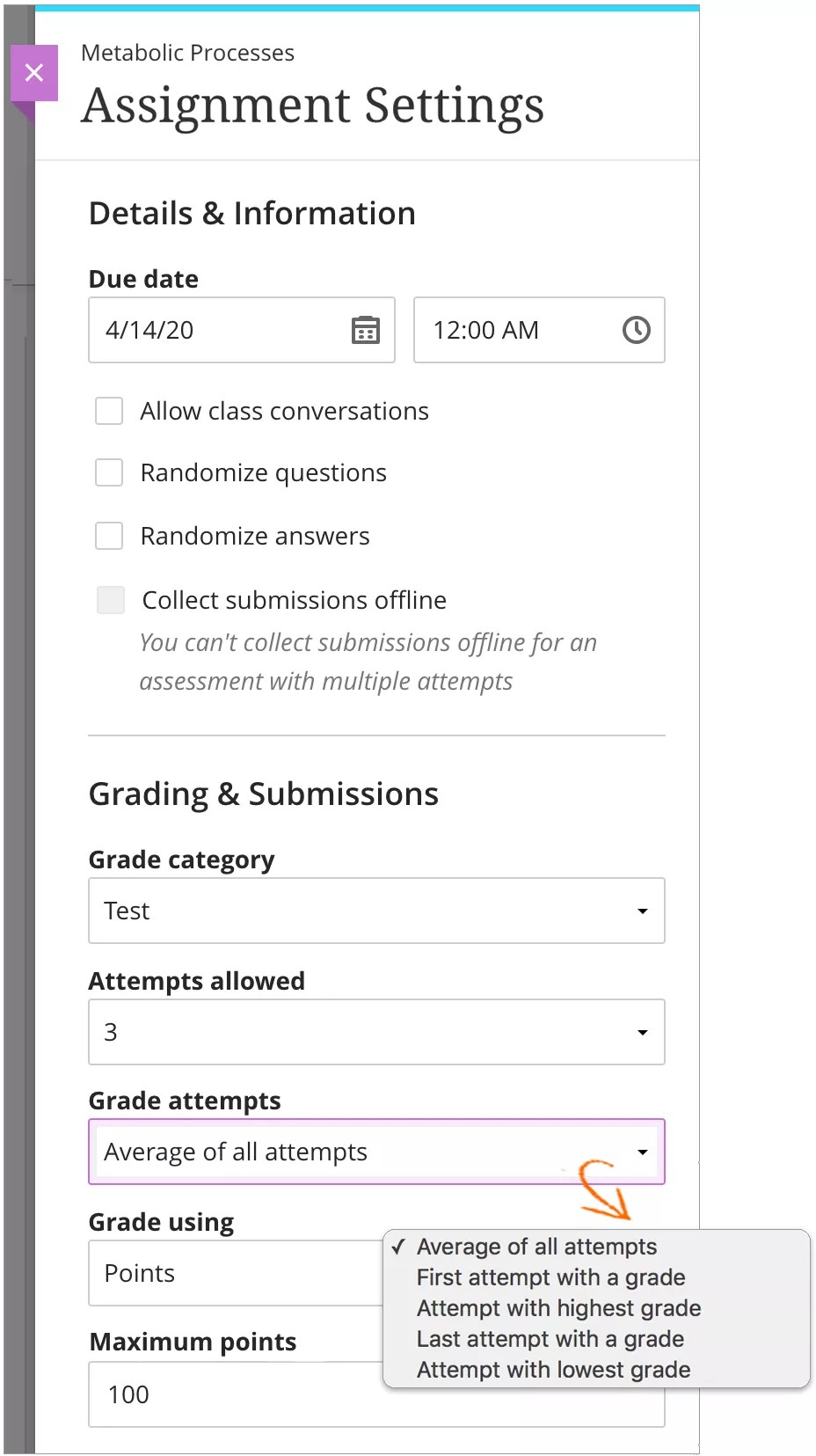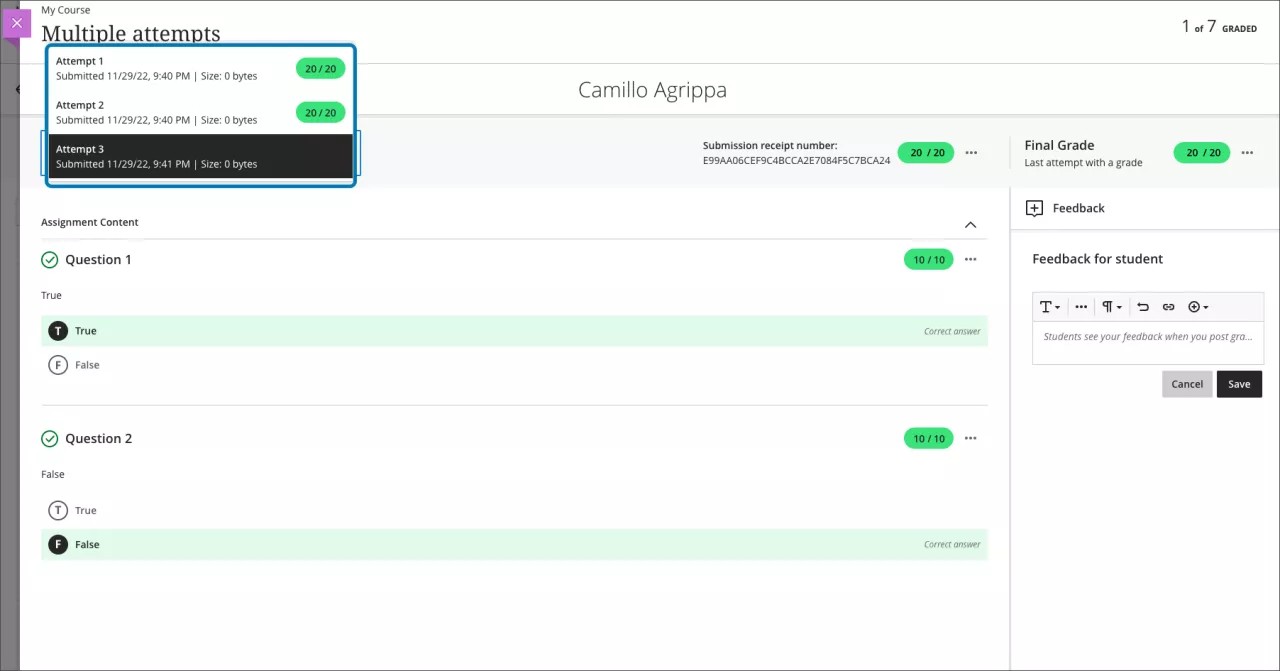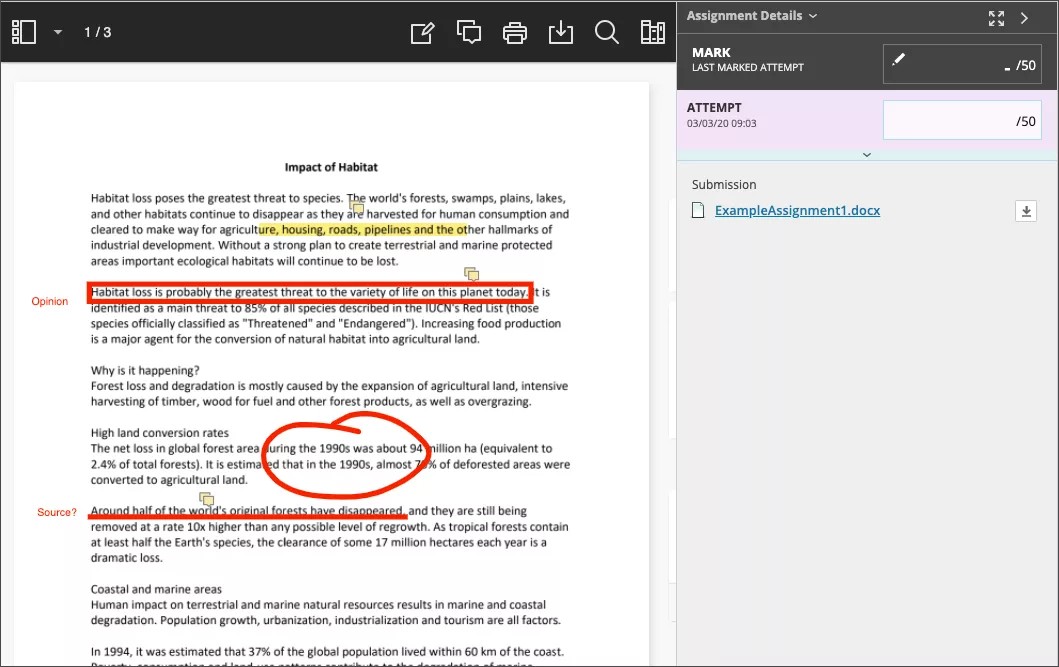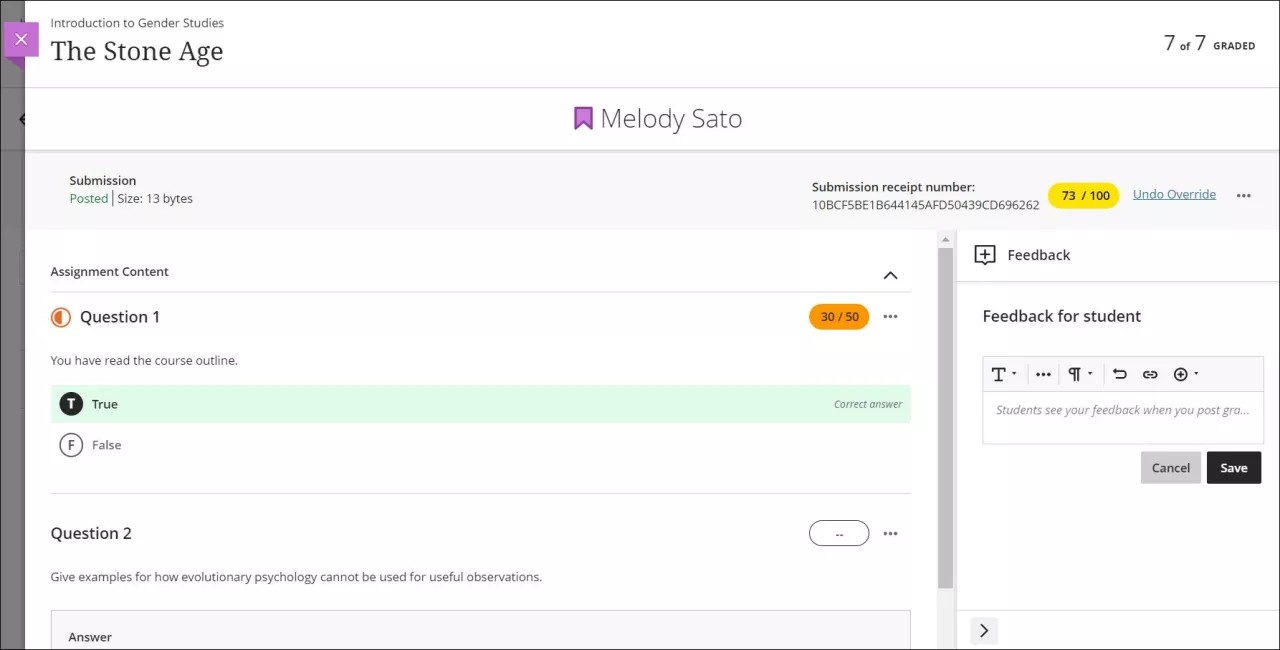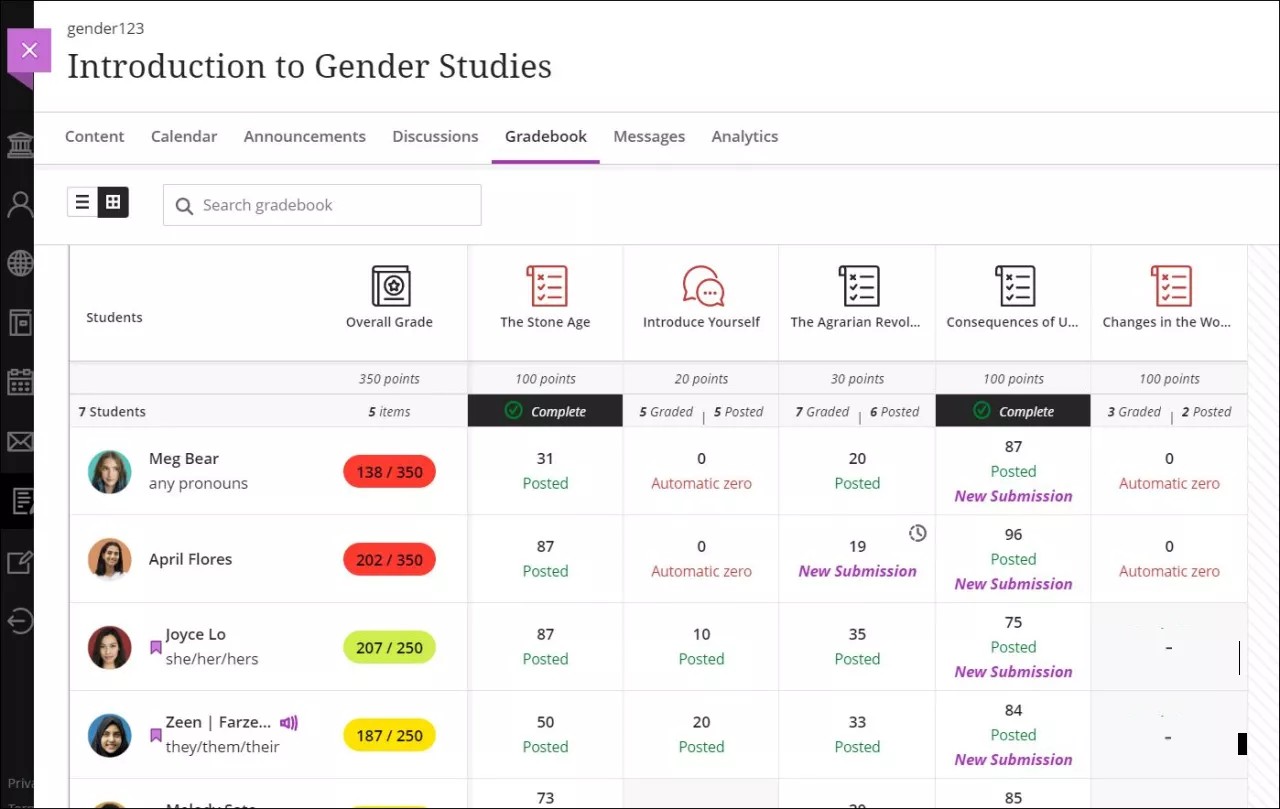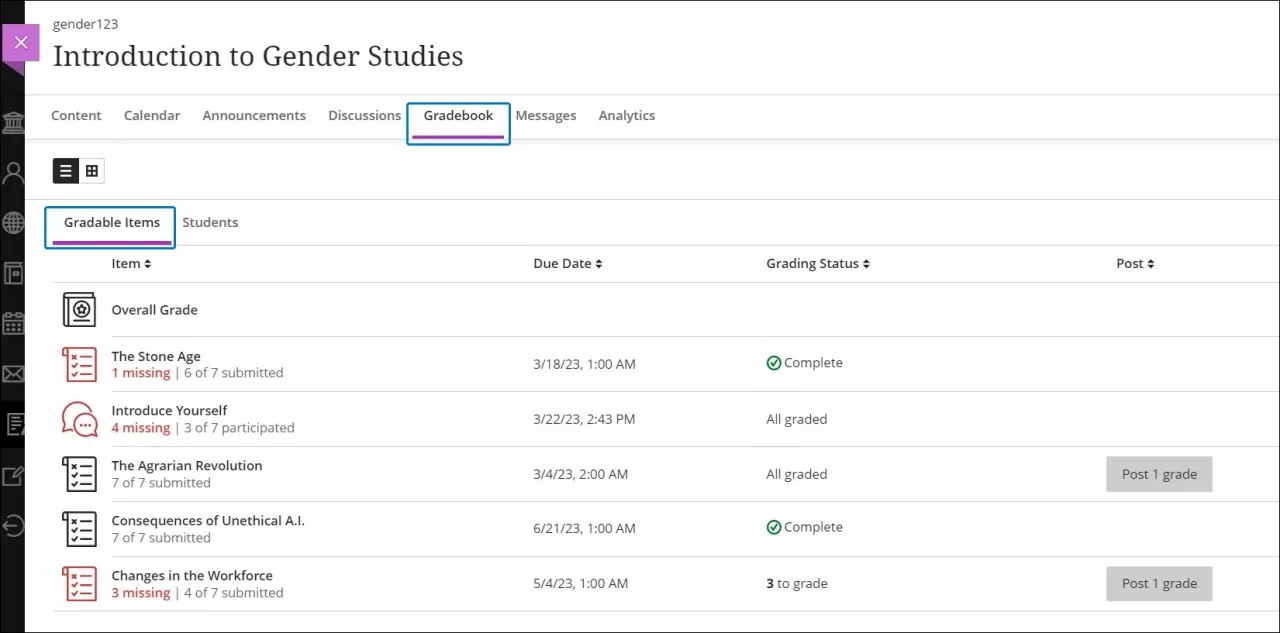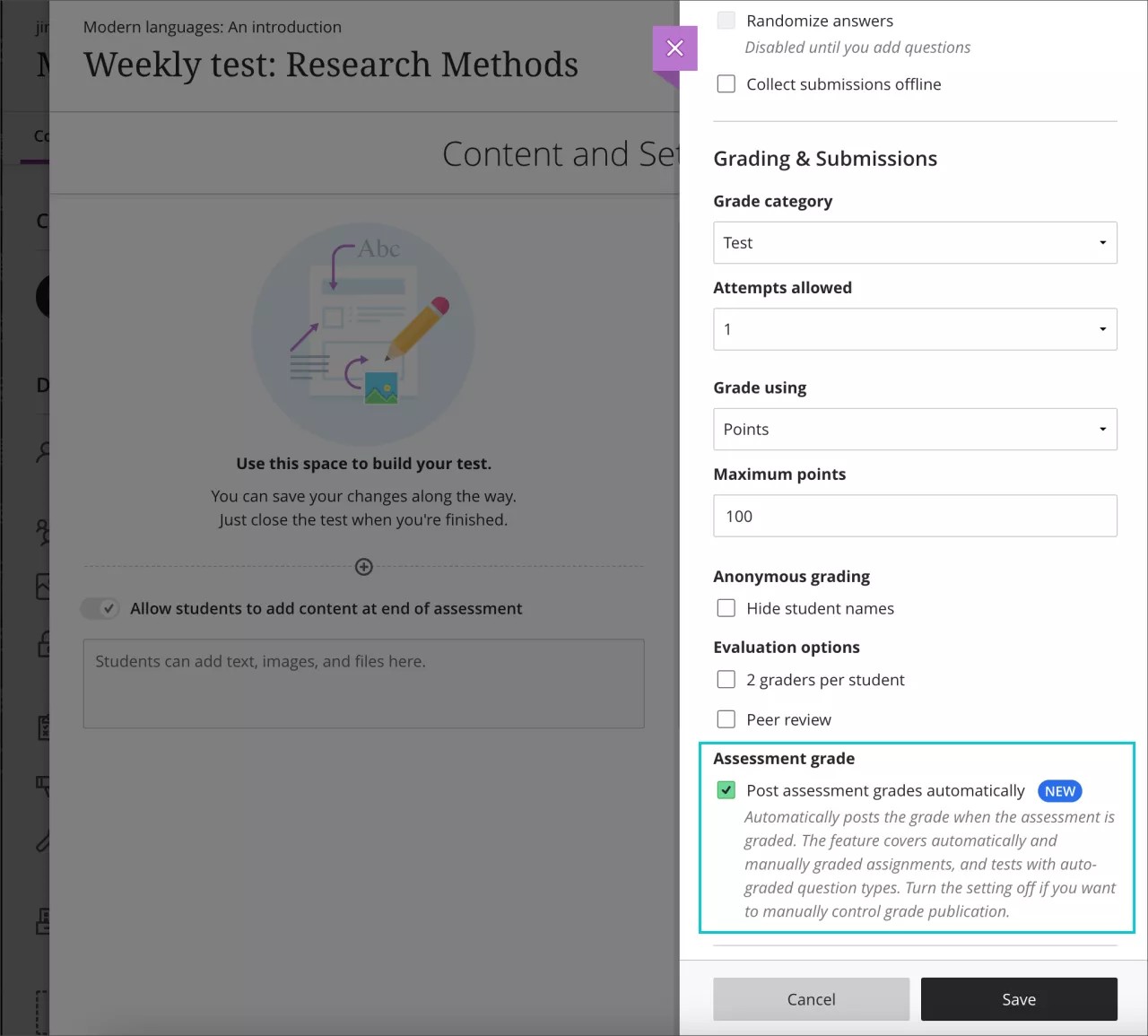Your institution controls which tools are available in the Original Course View. The gradebook is always available to instructors in the Ultra Course View.
You can choose where you want to start grading:
- From the Activity Stream
- From the base navigation menu
- From an assignment
- From the Gradebook
- From the Submissions page
Access grading from the Activity Stream
When student submissions are ready for grading, you’re alerted in the Activity Stream. Select New submissions ready to grade in the Activity Stream to go to the course’s Gradebook and start grading.
Access grading from the navigation bar
To view how many assignments are ready to be graded in all your courses and access grading options, select Grades from the left-hand navigation menu. All your grading tasks are listed by course. You see assignments that are ready to be graded, or assignments that are overdue for one or more students.
Access grading from an assignment
You can also start grading directly from an assignment in your course. Select the Submissions tab to see which students have completed the assignment and start grading.
Access grading from the Gradebook
Access the course Gradebook from the navigation bar in your course to see who has made submissions and start grading.
You can grade coursework, manage items, and post grades from three views:
Gradable Items view. The Gradable Items list is your default view. You can view all the coursework you've assigned, the grading status of each assignment, and whether or not there are grades to post.
Grades view. The Grades view displays the scores students have earned for each assignment and lets you know when you have assignments to grade. Select Grade Now from an assignment’s column to begin grading a student’s work.
Students view. The Students view lists the names of all your students with their dates of last access and their overall grades. You can only see overall grades if you’ve set up the overall grade for the course. Students with grading accommodations have a purple flag with their name.
Learn more about navigating the Gradebook
Access grading from the Submissions page
The Submissions page displays all enrolled students and allows you to keep track of all submissions on one page. You can access the Submissions page either from an assessment or from the Gradable items view in the Gradebook.
Quickly see which attempts are ready to grade. Use the Filter menu in the Submissions page to display only those submissions that need grading. The Filter menu doesn't appear for group and discussion items.
Student profile pictures appear with a red circle when they have late submissions or the due date has passed with no attempt submitted.
View submission timestamps
When you start or review grading, you can point to a submission timestamp to view more information. Timestamps appear on students' submission pages and on their attempts panels when you've allowed multiple attempts for an assessment.
For example, on a student's submission page, you can view when the student made the submission and when you posted the grade. The timestamp appears in red with a "late" label after the due date passes.
Grade an assignment with multiple attempts
Multiple attempts change how the assignment's final grade is automatically calculated. Choose how you want to calculate the final grade:
- Average of all attempts
- First attempt with a grade
- Attempt with highest grade
- Last attempt with a grade
- Attempt with lowest grade
By default, the grading page displays the most appropriate attempt based on the Grade attempts setting and the grading completion status:
| Grade Attempts setting | Grading completion status | Default attempt displayed |
| Last attempt with a grade | Any | Most recent attempt |
| First attempt with a grade | Any | First attempt |
| Attempt with the highest grade | All attempts are graded | Attempt with the highest grade |
| Attempt with the lowest grade | All attempts are graded | Attempt with the lowest grade |
| Average of all attempts | All attempts are graded | Most recent attempt |
| Attempt with the highest grade | There are ungraded attempts | Oldest ungraded attempt |
| Attempt with the lowest grade | There are ungraded attempts | Oldest ungraded attempt |
| Average of all attempts | There are ungraded attempts | Oldest ungraded attempt |
This allows you to quickly evaluate and grade student work. When the grade calculation method requires additional grading tasks, you are taken to that task. If not, the most appropriate graded attempt is displayed.
lsit
View individual attempts
You can grade an assignment with multiple attempts from the same places you grade an ordinary assignment:
- The Activity Stream
- The Gradebook
- The assignment
When you select a student's name, a panel appears that displays each attempt, along with the date it was submitted. Select an attempt to view the submission.
The feedback options appear next to each attempt. Select the chat bubble button to open the feedback panel. You can scroll through the assignment and add overall feedback and a grade.
Use the panel on the right to navigate through tabs such as rubrics, feedback, and originality report. You can also navigate the submission view and the panel tabs with different scroll bars. Independent scroll bars allow instructors or graders to scroll up and down the submission content without affecting the side tab navigation or the header.
Reminder: When you post grades, students can view them along with any feedback you provide. All feedback for all attempts, even ungraded attempts, is shown to students. If you used a rubric or questions that are scored automatically, the grade may already exist for the attempt.
Final grades
The final grade for a multiple attempt assignment is calculated based on the Grade Attempts setting you chose in the Assignment Settings. In the panel that lists a student's attempts, the final grade appears when those attempts are graded. For example, if the final grade is calculated based on the highest graded attempt, the final grade appears immediately after at least one attempt is graded. However, the grade may change as you continue grading more attempts. After you finish grading the attempts, you can post the final grade for the student to see.
What do students see?
Assignments with multiple attempts list the number of attempts allowed, as well as how the final grade is calculated. Students view this information on the Details & Information page before they begin. When grades are posted, students can view grades for each of their attempts, as well as the final grade. If you decide to override the final grade, a message appears to let the student know.
More on how students access assignments in Blackboard Learn
About Bb Annotate
Bb Annotate
You can use BB Annotate for inline grading in your courses. Bb Annotate offers a more robust feature set to provide customizable feedback to students. Features include a sidebar summary view, freehand drawing tools, various color selections, and much more.
BB Annotate grading workflow
On the Assignment Submission page, supported file types open in the browser. You can view and annotate these document types in the browser:
- Microsoft® Word (DOC, DOCX)
- Microsoft® PowerPoint®(PPT, PPTX)
- Microsoft® Excel®(XLS, XLSX)
- OpenOffice® Documents (ODS, ODT, ODP)
- Digital Images (JPEG, JPG, PNG, TIF, TIFF, TGA, BMP, HEIC)
- Source code (Java, PY, C, CPP, etc)
- Medical Images (DICOM, DICM, DCM)
- PSD
- RTF
- TXT
- WPD
Office Suite Macros, such as Visual Basic, aren't supported.
Annotation sessions expire after one hour. You'll receive a warning message before your session expires. Your completed annotations, feedback, and files are saved on the page. When you return, you can resume working.
Animated gifs display only the first frame in the pdf viewer for annotation purposes. Download the submission to view the animated gif.
Original formatting and embedded images are preserved. If a student submitted an unsupported file, you're prompted to download it. Assignment submissions created through the editor aren't compatible with inline grading.
Bb Annotate is supported on current versions of Firefox, Chrome, Edge, and Safari.
As part of the responsive design, the menu display changes based on the screen size. On medium and small screens, the Document View settings display the page number you're viewing. Annotation tools are stacked under the View Annotation Tools icon. On small screens, the Content Library is hidden.
Menu options from left to right
- Sidebar: View Thumbnail, Outline, or Annotation views of the submission.
- Pages: Use the arrows to jump to different pages in the submission.
- Pan: Move the submission on the page.
- Zoom and Fit: Zoom in and out of the submission or adjust the view to fit the page, fit the width, or select the best fit.
Annotation tools: Select each tool to view the tool properties.
Your selection for each tool is saved between submissions.
- Drawing, Brush, and Eraser: Draw freehand on the submission with various colors, thickness, and opacity. Select the eraser to remove annotations. You can erase parts of a freehand drawing with the eraser or select the Delete icon to delete the whole drawing.
- Image or Stamp: Choose a preloaded stamp or create your own customized stamp or image to add to the submission.
- Undo: Undo or revert the last thing you did.
- Redo: Repeat the last thing you did.
- Text: Add text directly on the submission. You can move, edit, and change the text and select the font, size, alignment, and color of the text.
- Shapes: Choose Line, Arrow, Rectangle, Ellipse, Polygon, and Polyline. Each shape has its own settings to change the color, width, opacity, and more.
Comment: Provide feedback in comments. Your comments appear in a panel next to the submission. You can make your comments anonymous by selecting the Anonymous button. You only have the option to make anonymous comments if your institution has turned them on.
Students can access the annotated files but won't be able to add annotations in their submissions.
Print or Download: Print or download the submission with the annotations.
A known issue with some browsers' built-in PDF viewer may not display all your annotations. Please view annotated PDFs in a native PDF viewer such as Adobe Acrobat.
- Search: Search the submission for specific text.
Content Library: Create a bank of reusable comments. You can add, edit, delete, and search comments in the library. You can also add a comment directly to the submission page from the menu. Select the plus sign to add a new comment to the Content Library. You can Place comment, Copy to Clipboard, Edit, or Delete content from the library. Type keywords or phrases to search for saved comments.<
The Content Library is only available in SaaS environments.
- Highlighter: Select specific portions of the submission to highlight. As you highlight text on the submission, an additional menu opens. You can highlight, strikethrough, underline, squiggle, or comment on the highlighted section.
Watch a video about Annotate in Blackboard Learn
The following narrated video provides a visual and auditory representation of some of the information included on this page. For a detailed description of what is portrayed in the video, open the video on YouTube, navigate to More actions, and select Open transcript.
Video: Annotate in Blackboard Learn provides a tour of the Annotate tools available for inline grading in your Blackboard Learn courses.
Grade an assignment with a time limit
When you allow students to work past the time limit for an assignment, you're able to view which assignments exceeded the time limit. If you added questions, you can also view how many questions were answered after the time limit.
More on grading work with a time limit
Grading and feedback using rubrics
You can create a rubric, associate it to an assignment or discussion, and use it for grading. The rubric will appear on the assignment or discussion page you chose. Please note that you can only associate one rubric to each item. You can’t associate a rubric to an assignment with questions.
Learn more about creating rubrics
Lean more about grading with a rubric and providing feedback
Assigning a grade
Select student names from the Submissions page to access their individual submissions, assign grades, and provide feedback.
You can also access an attempt from the Gradebook grid view.
Overriding grades
Override grades are grades you assign manually. An example is if you type in the grade pill in the Gradebook. An override label appears next to the grade.
If you allow multiple attempts, when you manually edit the final grade for an item, you're assigning an override grade.
Learn more about overriding grades
Learn more about grade pills
Adding feedback
To provide feedback, open an attempt. On the submission page, select the chat bubble button to open the feedback panel. The panel remains in place as you scroll through the assignment and add overall feedback and a grade.
Insert a feedback recording in the editor. You can embed an audio or video recording of your feedback in the editor as you grade attempts. The recording option appears in the feedback editor for most graded items in your course. Students watch or listen to your feedback alongside any text you include.
This feature isn't supported on all browsers. For the best experience, use Chrome or Firefox.
More on adding audio/video feedback
Posting grades
You can post grades from:
- The base navigation Grades page
- The Gradable items view in the Gradebook
- The Submissions page
To publish a grade, select Post grade, which appears next to each grade you haven't released yet. You can choose which grades to post and when. Posted grades are labeled Posted.. You can also grade all submissions for an item and then select Post all grades to release all grades in one action.
When you post grades, students can view them, along with any feedback you provide. All feedback for all attempts, even ungraded attempts, is shown to students.
Post grades automatically. If you wish grades to be posted as soon as an attempt is graded, select the Post assessment grades automatically option in the assessment settings panel. This setting is not selected by default for assignments, but it is for new tests. To prevent grades from auto posting, simply de-select this option and post grades manually.
Add exceptions. From a student's submission page, access the menu next to the grade pill to add an exception for the assignment. An exception includes additional attempts or extended access, even if the assignment is hidden from other students. You can also add exceptions after you post grades.
Offline grading
If it’s more convenient to you, you can download students' assessment submissions and view them offline.
Select the download button from these areas in the gradebook:
- Grade Item's view: From the item's Submissions page, select the … menu in the header row
- Grades view: Item's menu

